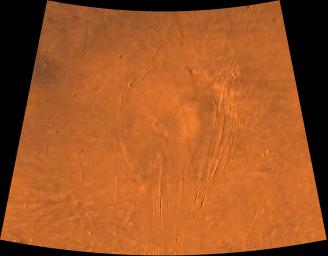
|
Alba Patera
- Click the image above for a larger view
- Full-Res JPEG (3532 x 2763) (760.6 kB)
- Full-Res TIFF (3532 x 2763) (14.7 MB)
Caption:
A color image of the Alba Patera region of Mars; north toward top. The scene shows a central circular depression surrounded by splays of fractures, named Alba Fossae (west of Alba Patera) and Tantalus Fossae (east of Alba Patera). A patera (Latin for shallow dish or saucer) is a volcano of broad areal extent with little vertical relief; a fossa is a linear depression.
This image is a composite of Viking medium-resolution images in black and white and low-resolution images in color. The image extends from latitude 30 degrees N. to 50 degrees N. and from longitude 95 degrees to 125 degrees; Lambert projection.
Alba Patera has a 100-km-diameter caldera at its center surrounded by a fracture ring. In total, the approximately 1,200- km-diameter Alba Patera far exceeds any other known volcano in areal extent; it covers eight times the area of Olympus Mons (the highest volcano in the Solar System) but reaches only about 6 km in height. The patera lies directly north of the Tharsis bulge, which encompasses the most intensely and most recently active volcanic region of the planet. The fossae of the Alba area are fault-bound graben that can be traced south through the Tharsis bulge and therefore likely formed by upwarping of the Tharsis bulge as well as the coeval upwelling of Alba Pateria magma.
Cataloging Keywords:
| Name | Value | Additional Values |
|---|---|---|
| Target | Mars | |
| System | ||
| Target Type | Planet | |
| Mission | Viking | |
| Instrument Host | Viking 1 Orbiter | Viking 2 Orbiter |
| Host Type | Orbiter | |
| Instrument | ||
| Detector | ||
| Extra Keywords | Color, Mountain, Volcano | |
| Acquisition Date | ||
| Release Date | 1998-06-08 | |
| Date in Caption | ||
| Image Credit | NASA/JPL/USGS | |
| Source | photojournal.jpl.nasa.gov/catalog/PIA00409 | |
| Identifier | PIA00409 | |
